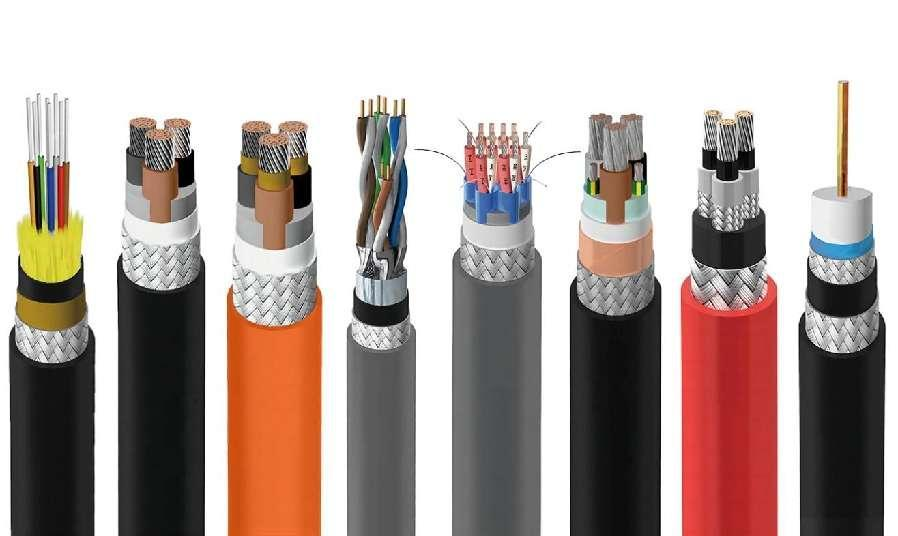When planning or upgrading your home wiring or home rewiring in Toronto, one of the most important — and often overlooked — details is choosing the right type of electrical cable. Each type of cable is designed for a specific application, load capacity, and safety requirement. Using the wrong cable can lead to voltage drops, circuit overloads, or even fire hazards.
As a trusted electrical contractor in GTA, Pioneer Electrics ensures that every wire and connection in your home meets Ontario Electrical Code (OESC) standards and performs safely for years to come. In this guide, we’ll explain the most common electrical cable types used in modern homes, their differences, and where each one should be used.
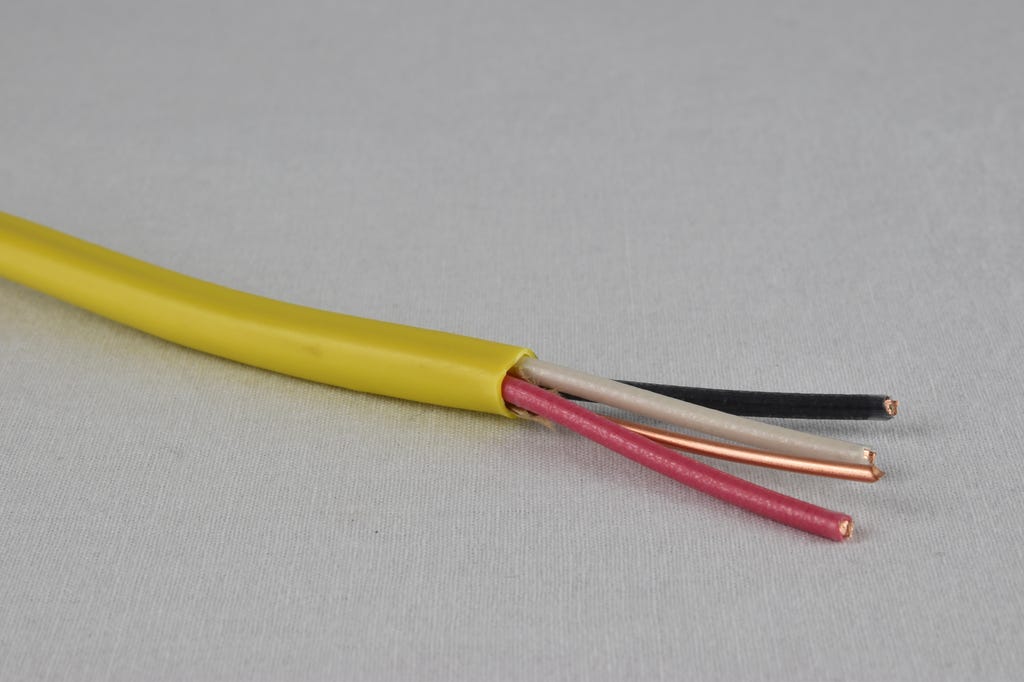
NM Cable
1. NM (Non-Metallic Sheathed Cable – Romex)
Description:
NM cable, commonly known by the trade name Romex, is the most widely used wiring for residential indoor circuits. It consists of two or more insulated conductors and a bare ground wire, all wrapped in a non-metallic PVC sheath.
Common sizes:
-
14/2 — used for 15-amp lighting circuits.
-
12/2 — used for 20-amp outlets and small appliances.
-
12/3 or 14/3 — used when a circuit requires two hot wires, such as 3-way switches.
Where it’s used:
-
Lighting circuits
-
General wall outlets
-
Small appliances
Why it’s ideal for homes:
NM cable is flexible, easy to install, and cost-effective. It’s suitable for dry indoor areas such as walls, ceilings, and crawl spaces. However, it should never be used outdoors or in damp locations.
Standards and markings:
NM cables must meet CSA and UL ratings, typically marked “NM-B” for 90°C rated insulation.
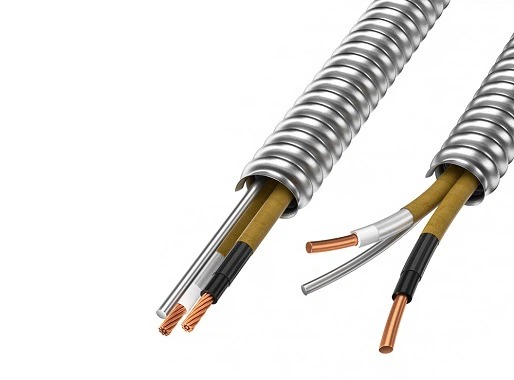
BX or AC (Armored Cable)
2. BX or AC (Armored Cable)
Description:
BX or Armored Cable (AC) features a flexible metal sheath that protects the conductors inside. It’s commonly used where extra mechanical protection is needed.
Common sizes:
12 AWG or 10 AWG, depending on circuit amperage.
Where it’s used:
-
Basements and utility rooms
-
Garages and workshops
-
Exposed indoor runs where conduit isn’t practical
Benefits:
-
The metal armor acts as a grounding conductor.
-
Provides better physical protection than NM cable.
-
Resistant to rodents and accidental damage.
Installation note:
BX cable must be properly clamped at junction boxes to maintain grounding continuity. Pioneer Electrics ensures all armored cables are installed per Ontario safety code and manufacturer standards.
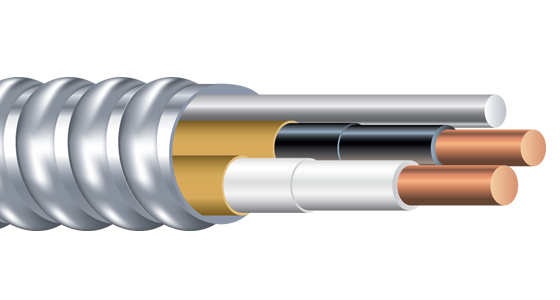
MC
3. MC (Metal-Clad Cable)
Description:
Similar to BX, but with a separate ground wire rather than relying on the metal sheath. MC cable offers superior safety and flexibility.
Where it’s used:
-
Kitchens and utility rooms
-
Commercial-grade home projects
-
Areas requiring higher load or durability
Benefits:
-
CSA-approved for more environments than BX.
-
Suitable for both dry and damp locations.
-
Easier to ground and bond.
Tip:
When we perform home rewiring in Toronto, MC cable is often chosen for remodels where open framing allows easy access, but added protection is desired.
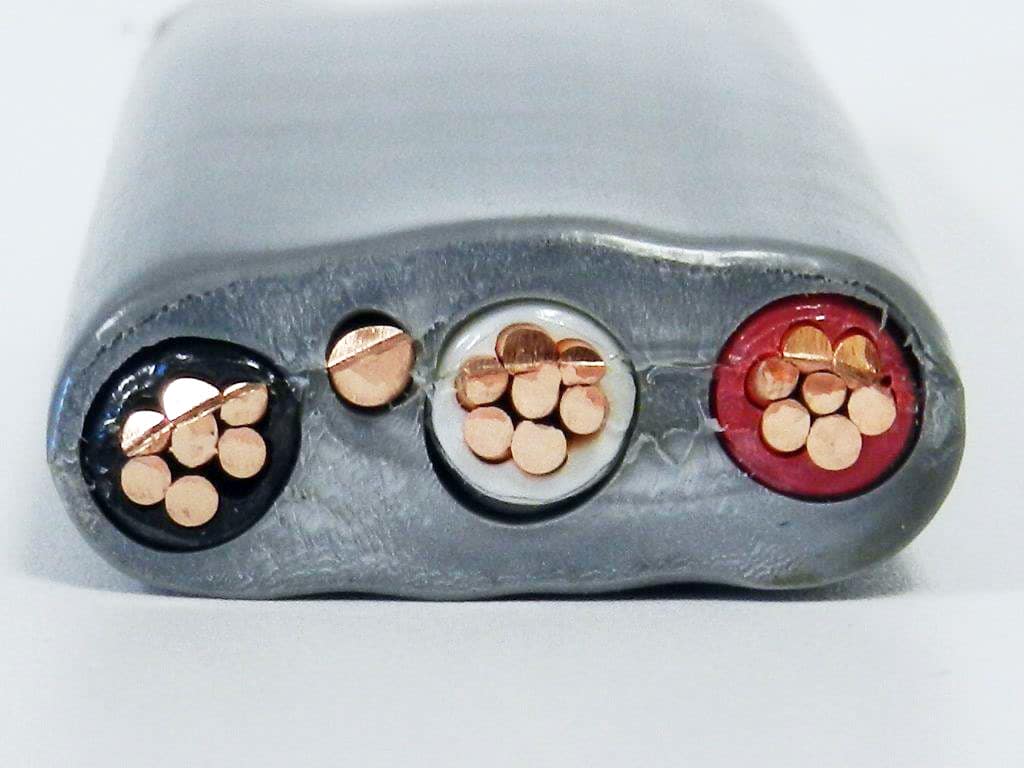
UF (Underground Feeder Cable)
4. UF (Underground Feeder Cable)
Description:
UF cable is similar in appearance to NM cable but has a solid, moisture-resistant sheath designed for outdoor or underground use.
Common sizes:
-
12/2 UF — for outdoor lighting or garden receptacles.
-
10/2 UF — for higher-load outdoor equipment.
Where it’s used:
-
Outdoor lighting circuits
-
Detached garages and sheds
-
Underground wiring to landscape or pool areas
Features:
-
Sunlight-resistant and waterproof.
-
Can be buried directly in the ground (minimum depth 24 inches per code).
-
More rigid than NM cable due to its solid jacket.
Professional tip:
When running outdoor circuits, Pioneer Electrics always adds GFCI protection and follows ESA burial depth regulations to ensure long-term safety and compliance.
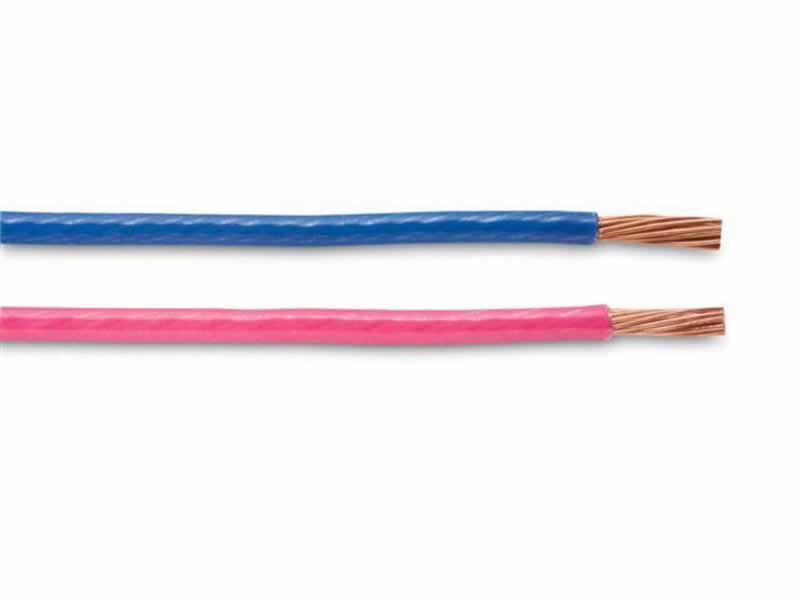
THHN/THWN Wires
5. THHN/THWN Wires (in Conduit)
Description:
THHN (Thermoplastic High Heat-Resistant Nylon-coated) and THWN (Thermoplastic Heat and Water-Resistant Nylon-coated) are single insulated conductors run inside electrical conduits such as EMT or PVC.
Where it’s used:
-
Outdoor circuits
-
Garages, basements, or exposed wiring routes
-
Upgrades in home rewiring in Toronto projects requiring conduit
Benefits:
-
High heat resistance (up to 90°C).
-
Suitable for wet or dry conditions.
-
Available in many colors for easy identification.
Sizes and ratings:
Common sizes include 14 AWG (for lighting) to 4 AWG (for subpanels). Each wire is color-coded — black/red for hot, white for neutral, green for ground.
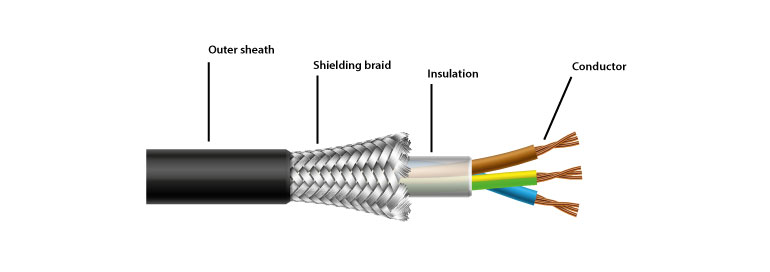
Shielded Cable
6. Shielded Cable (for Low-Voltage and Sensitive Circuits)
Description:
Shielded cables have a metallic foil or braided shield surrounding the conductors to protect against electromagnetic interference (EMI).
Where it’s used:
-
Home automation and smart lighting systems
-
Audio/video or security camera wiring
-
Data cables for networking or control systems
Benefits:
-
Reduces signal interference.
-
Improves system stability and performance.
-
Essential in modern “smart homes” where devices share close proximity.
Note:
Shielded cables aren’t typically used for 120V power, but they play a vital role in low-voltage wiring integrated with home lighting, HVAC controls, and alarm systems — services frequently included in home wiring upgrades by Pioneer Electrics.
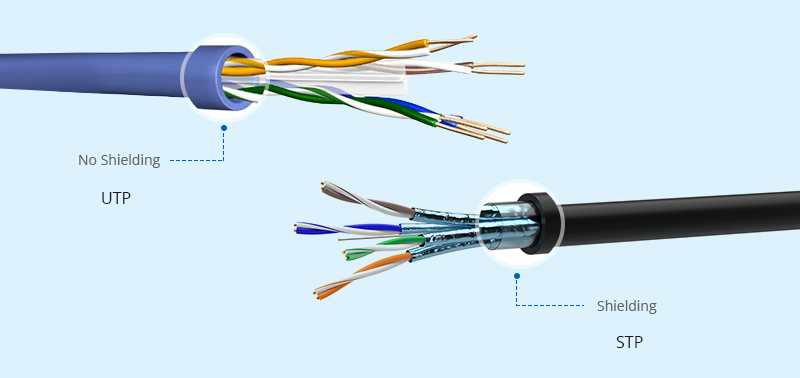
Coaxial and Ethernet
7. Coaxial and Ethernet (Low-Voltage Structured Wiring)
Description:
While not power cables, coaxial (RG6) and Ethernet (Cat6 or Cat7) cables are essential parts of modern residential electrical systems.
Where it’s used:
-
TV and internet connections
-
Home offices and smart device networks
Standards:
-
Cat6 cables support gigabit speeds up to 250 MHz.
-
Cat7 offers shielding for improved performance.
Why it matters:
As part of a comprehensive home wiring project, integrating structured cabling ensures your home is ready for the future of smart technology.
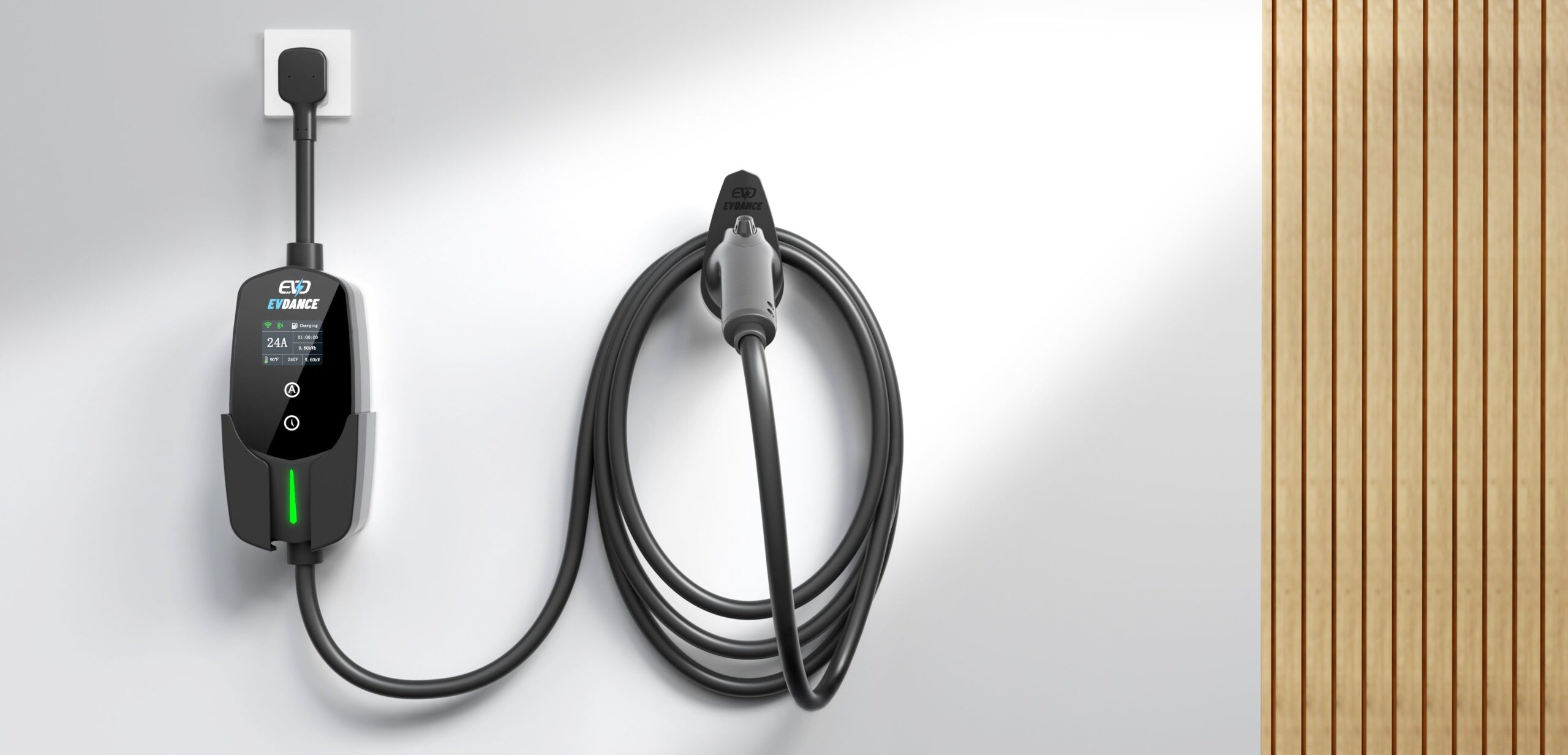
Specialty Cables
8. Specialty Cables (Range, Dryer, and EV Charger Circuits)
Description:
Large appliances and EV chargers require heavier-gauge cables rated for higher current.
Examples:
-
8/3 cable — for electric ranges and dryers.
-
6/3 or 4/3 cable — for Level 2 EV chargers or subpanels.
Where it’s used:
-
Kitchens, laundry rooms, and garages.
Standards:
Must meet CSA C22.2 standards and be installed on dedicated circuits with appropriate breakers.
Safety Note:
High-current circuits demand careful load calculation and proper cable size selection. At Pioneer Electrics, we perform load assessments before installation to ensure cables never exceed 80% of rated capacity — preventing overheating and ensuring safe operation.
Cable Sizing and Ampacity Overview
The correct wire gauge (AWG) depends on the amperage of the circuit.
Here’s a quick reference used by electricians in the GTA:
| Circuit Type | Typical Load | Wire Size (Copper) | Breaker Size |
|---|---|---|---|
| Lighting | 15A | 14 AWG | 15A |
| General Outlets | 20A | 12 AWG | 20A |
| Large Appliances | 30A | 10 AWG | 30A |
| Range / Dryer | 40–50A | 8 AWG / 6 AWG | 40–50A |
| EV Charger / Subpanel | 50–60A | 6 AWG / 4 AWG | 50–60A |
Canadian and Ontario Standards to Know
In Toronto and across the GTA, electrical installations must comply with:
-
CSA C22.1 (Canadian Electrical Code, Part I)
-
OESC (Ontario Electrical Safety Code)
-
ESA Inspection Requirements
Using approved cable types (CSA or UL marked) ensures legal compliance and insurance protection. Unapproved or undersized cables are a major cause of home electrical failures.
Why Hire a Licensed Electrical Contractor in GTA
Working with a licensed electrical contractor in GTA ensures:
-
ESA permits and inspections are handled properly.
-
Correct cable types and gauges are used for each circuit.
-
Work is fully insured and compliant with the Ontario code.
-
Your home wiring system is future-ready for smart technologies.
At Pioneer Electrics, we combine code knowledge with practical experience to deliver safe, clean, and efficient wiring installations throughout Toronto homes.
Final Thoughts
Understanding the different types of electrical cables helps you make smarter decisions about your home wiring system. From basic NM cables to advanced shielded and underground feeders, each type plays a unique role in keeping your home safe, efficient, and up to code.
If you’re planning a renovation or home rewiring in Toronto, trust Pioneer Electrics, your experienced electrical contractor in GTA, to design and install a system that meets today’s standards and tomorrow’s technology needs.


